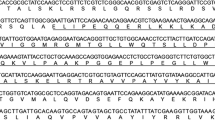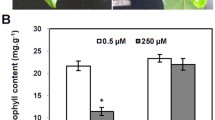Abstract
Rice exhibits the greatest aluminum (Al) tolerance compared with other cereals such as wheat, barley, maize, etc. A full-length gene, OsCS1, encoding citrate synthase, which is highly induced by aluminum toxicity in rice (Oryza sativa L.), was isolated. Sequence analysis and the sub-cellular localization of OsCS1 in yeast revealed that it is a mitochondrial citrate synthase. OsCS1 was induced by Al toxicity. Several independent transgenic tobacco lines expressing OsCS 1 exhibitted increased citrate efflux and extraordinary Al tolerance. Possible outlook for OsCS1 to be applied to enhance plant tolerance to Al toxicity was also discussed.






Similar content being viewed by others
References
van Breemen, N., Mulder, J., & van Grinsven, J. J. M. (1987). Impacts of acid Atmospheric deposition on woodland soils in the Netherlands: II. Nitrogen transformations. Soil Science Society of America, 51, 634–1640.
Von Uexkull, H. R., & Mutert, E. (1995). Global extent development and economic of acid soils. Plant and Soil, 171, 1–15. doi:10.1007/BF00009558.
Ma, J. F., Nagao, S., Huang, C. F., & Nishimura, M. (2005). Isolation and characterization of a rice mutant hypersensitive to Al. Plant and Cell Physiology, 46, 1054–1061. doi:10.1093/pcp/pci116.
Zheng, S. J., Ma, J. F., & Matsumoto, H. (1998). High aluminum resistance in buckwheat. I. Al-induced specific secretion of oxalic acid from root tips. Plant Physiology, 117, 745–751. doi:10.1104/pp.117.3.745.
Yang, J. L., Zheng, S. J., He, Y. F., & Matsumoto, H. (2005). Aluminium resistance requires resistance to acid stress: A case study with spinach that exudes oxalate rapidly when exposed to Al stress. Journal of Experimental Botany, 414, 1197–1203. doi:10.1093/jxb/eri113.
Yang, J. L., Zheng, S. J., He Y. F., You, J. F., Zhang, L., & Yu, X. H. (2006) Comparative studies on the effect of a protein-synthesis inhibitor on aluminium-induced secretion of organic acids from Fagopyrum esculentum Moench and Cassia tora L. roots. Plant, Cell & Environment, 29, 240–246. doi:10.1111/j.1365-3040.2005.01416.x.
Paul, B. L., Degenhardt, J., Tai, C. Y., Laura, M. S., Stephen, H. H., & Leon, V. K. (1998). Aluminum-resistant Arabidopsis mutants that exhibit altered patterns of aluminum accumulation and organic acid release from roots. Plant Physiology, 117, 9–18. doi:10.1104/pp.117.1.9.
Koyama, H., Kawamura, A., Kihara, T., Hara, T., Takita, E., & Shibata, D. (2000). Overexpression of mitochondrial citrate synthase in Arabidopsis thaliana improved growth on a phosphorus-limited soil. Plant and Cell Physiology, 41, 1030–1037. doi:10.1093/pcp/pcd029.
Anoop, V. M., Basu, U., McCammon, M. T., McAlister-Henn, L., & Taylor, G. J. (2003). Modulation of citrate metabolism alters aluminum tolerance in yeast and transgenic canola overexpressing a mitochondrial citrate synthase. Plant Physiology, 132, 2205–2217. doi:10.1104/pp.103.023903.
de la Fuente, J. M., Ramyrez-Rodryguez, V., Cabrera-Ponce, J. L., & Herrera-Estrella, L. (1997). Aluminum tolerance in transgenic plants by alteration of citrate synthesis. Science, 276, 1566–1568. doi:10.1126/science.276.5318.1566.
Tesfaye, M., Temple, S. J., Allan, D. L., Vance, C. P., & Samac, D. A. (2001). Overexpression of malate dehydrogenase in transgenic alfalfa enhances organic acid synthesis and confers tolerance to aluminum. Plant Physiology, 127, 1836–1844. doi:10.1104/pp.010376.
Li, X. F., Ma, J. F., & Matsumoto, H. (2000). Pattern of aluminum-induced secretion of organic acids differs between Rye and Wheat. Plant Physiology, 123, 1537–1543. doi:10.1104/pp.123.4.1537.
Unger, E. A., Hand, J. M., Cashmore, A. R., & Vasconcelos, A. C. (1989). Isolation of a cDNA encoding mitochondrial citrate synthase from Arabidopsis thaliana. Plant Molecular Biology, 13, 411–418. doi:10.1007/BF00015553.
Koyama, H., Takita, E., Kawamura, A., Hara, T., & Shibata, D. (1999). Overexpression of mitochondrial citrate synthase gene improves the growth of carrot cells in aluminum-phosphate medium. Plant and Cell Physiology, 40, 482–488.
Yoshida, S., Forno, D. A., Cook, J. H., & Gomez, K. A. (1976). Laboratory manual for physiological studies of rice. Manila, Philippines: International Rice Research Institute.
Schwede, T., Kopp, J., Guex, N., & Peitsch, M. C. (2003). SWISSMODEL: An automated protein homology-modeling server. Nucleic Acids Research, 31, 3381–3385. doi:10.1093/nar/gkg520.
Guex, N., & Peitsch, M. C. (1997). SWISS-MODEL and the Swiss- PdbViewer: An environment for comparative protein modeling. Electrophoresis, 18, 2714–2723. doi:10.1002/elps.1150181505.
Zhang, S. S., Ming, F., Lu, Qun., Guo, B., & Shen, D. L. (2005). Molecular cloning and characterization of citrate synthase gene in rice (Oryza sativa L.). La Ricerca Scientifica, 12, 233–237.
Hartl, F. U., Pfanner, N., Nicholson, D. W., & Neupert, W. (1989). Mitochondrial protein import. Biochimica et Biophysica Acta, 988, 1–45.
Pfanner, N., & Neupert, W. (1990). The mitochondrial protein import apparatus. Annual Review of Biochemistry, 59, 331–353. doi:10.1146/annurev.bi.59.070190.001555.
Attardi, G., & Schatz, G. (1988). Biogenesis of mitochondria. Annual Review of Cell Biology, 4, 289–333. doi:10.1146/annurev.cb.04.110188.001445.
Arnott, M. A., Michael, R. A., Thompson, C. R., Hough, D. W., & Danson, M. J. (2000). Thermostability and thermoactivity of citrate synthases from the thermophilic and hyperthermophilic archaea, Thermoplasma acidophilum and Pyrococcus furiosus. Journal of Molecular Biology, 304, 657–668. doi:10.1006/jmbi.2000.4240.
Lopez-Bucio, J., de La Vega, O. M., Guevara-Garcia, A., & Herrera-Estrella, L. (2000). Enhanced phosphorus uptake in transgenic tobacco plants that overproduce citrate. Nature Biotechnology, 18, 450–453. doi:10.1038/74531.
Landschutze, V., Muller-Rober, B., & Willmitzer, L. (1995). Mitochondrial citratesynthase from potato: Predominant expression in mature leaves and young flower buds. Planta, 196, 756–764. doi:10.1007/BF01106771.
Ma, J. F., Shen, R., Zhao, Z., Wissuwa, M., Takeuchi, Y., Ebitani, T., et al. (2002). Response of rice to Al stress and identification of quantitative trait Loci for Al tolerance. Plant and Cell Physiology, 43, 652–659. doi:10.1093/pcp/pcf081.
Foy, C. D. (1988). Plant adaptation to acid, aluminum-toxic soils. Communications in Soil Science and Plant Analysis, 19, 959–987. doi:10.1080/00103628809367988.
Delhaize, E., Ryan, P. R., & Randall, P. J. (1993). Aluminum tolerance in wheat (Triticum aestivum L.) (II. Aluminum-stimulated excretion of malic acid from root apices). Plant Physiology, 103, 695–702.
Pellet, D., Grunes, D., & Kochian, L. (1995). Organic acid exudation as an aluminum-tolerance mechanism in maize (Zea mays L.). Planta, 196, 788–795. doi:10.1007/BF01106775.
Acknowledgment
The study was supported by the National Science Foundation of China (NSFC), No. 30570988, the Program for New Century Excellent Talents in University, No. NCET- 07- 020, and the Youth Science and Technology Phosphor Foundation of Shanghai (08QH14003).
Author information
Authors and Affiliations
Corresponding author
Rights and permissions
About this article
Cite this article
Han, Y., Zhang, W., Zhang, B. et al. One Novel Mitochondrial Citrate Synthase from Oryza sativa L. can Enhance Aluminum Tolerance in Transgenic Tobacco. Mol Biotechnol 42, 299–305 (2009). https://doi.org/10.1007/s12033-009-9162-z
Received:
Accepted:
Published:
Issue Date:
DOI: https://doi.org/10.1007/s12033-009-9162-z




